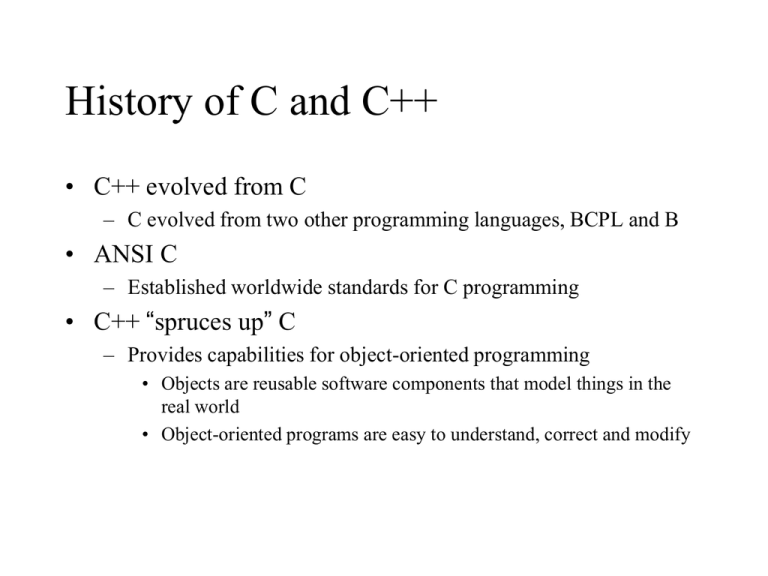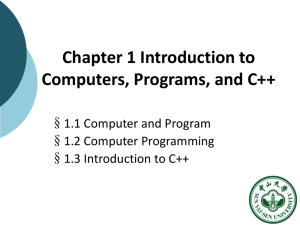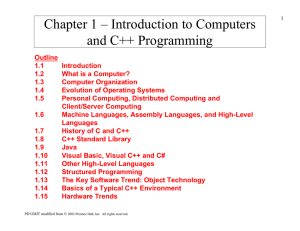History of C and C++ • C++ evolved from C
advertisement

History of C and C++
• C++ evolved from C
– C evolved from two other programming languages, BCPL and B
• ANSI C
– Established worldwide standards for C programming
• C++ “spruces up” C
– Provides capabilities for object-oriented programming
• Objects are reusable software components that model things in the
real world
• Object-oriented programs are easy to understand, correct and modify
C++ Standard Library
• C++ programs
– Built from pieces called classes and functions
• C++ standard library
– Provides rich collections of existing classes and
functions for all programmers to use
Structured Programming
• Structured programming
– Disciplined approach to writing programs
– Clear, easy to test and debug, and easy to
modify
• Multitasking
– Many activities to run in parallel
Basics of a Typical C++ Environment
Phases of C++ Programs:
1. Edit
Editor
Disk
Preprocessor
Disk
Compiler
Disk
Linker
Disk
2. Preprocess
3. Compile
4. Link
5. Load
6. Execute
Loader
Primary
Memor
Program is created
in
the editor and stored
on disk.
Preprocessor
program
processes the code.
Compiler creates
object code and
stores
the object
itlinks
on disk.
code with the
libraries,
creates a.out and
stores it on disk
y
Loader puts program
in memory.
Disk
CP
U
..
..
..
Primary
Memor
y
..
..
..
CPU takes each
instruction and
executes it, possibly
storing new data
values as the
program
executes.
Introduction to C++ Programming
• C++ language
– Facilitates a structured and disciplined approach to
computer program design
• Following are several examples
– The examples illustrate many important features of C++
– Each example is analyzed one statement at a time.
1
// Fig. 1.2: fig01_02.cpp
2
// A first program in C++
3
#include <iostream>
Written between /* and */ or following a //.
4
5
void main()
6
{
7
Improve program readability and do not cause the
computer to perform any action.
preprocessor directive
std::cout << "Welcome to C++!\n";
8
9
Comments
Message to the C++ preprocessor.
Lines beginning with # are preprocessor directives.
}
Welcome to C++!
#include <iostream> tells the preprocessor to
include
the contents
theor
filemore
<iostream>,
which
C++
programs
containofone
functions, one
of
includes
input/output
which
must
be main operations (such as printing to
the screen).
Parenthesis are used to indicate a function
Prints the string of characters contained between the
quotation marks.
A left
brace { begins
The entire line, including
std::cout,
the the
<< body of every function
and a right to
braceC++!\n"
} ends it. and
operator, the string "Welcome
the semicolon (;), is called a statement.
All statements must end with a semicolon.
A Simple Program: Printing a Line of Text
• std::cout
– Standard output stream object
– “Connected” to the screen
– std:: specifies the "namespace" which cout belongs to
• std:: can be removed through the use of using statements
• <<
– Stream insertion operator
– Value to the right of the operator (right operand) inserted into
output stream (which is connected to the screen)
– std::cout << “Welcome to C++!\n”;
• \
– Escape character
– Indicates that a “special” character is to be output
A Simple Program:
Printing a Line of Text
Escape Sequence
Description
\n
Newline. Position the screen cursor to the
beginning of the next line.
\t
Horizontal tab. Move the screen cursor to the next
tab stop.
\r
Carriage return. Position the screen cursor to the
beginning of the current line; do not advance to the
next line.
\a
Alert. Sound the system bell.
\\
Backslash. Used to print a backslash character.
\"
Double quote. Used to print a double quote
character.
• There are multiple ways to print text
– Following are more examples
1
// Fig. 1.4: fig01_04.cpp
2
// Printing a line with multiple statements
3
#include <iostream>
4
5
void main()
6
{
7
std::cout << "Welcome ";
8
std::cout << "to C++!\n";
9
10 }
Welcome to C++!
Unless new line '\n' is specified, the text continues
on the same line.
1
// Fig. 1.5: fig01_05.cpp
2
// Printing multiple lines with a single statement
3
#include <iostream>
4
5
void main()
6
{
7
std::cout << "Welcome\nto\n\nC++!\n";
8
9
}
Welcome
to
C++!
Multiple lines can be printed with one
statement.



